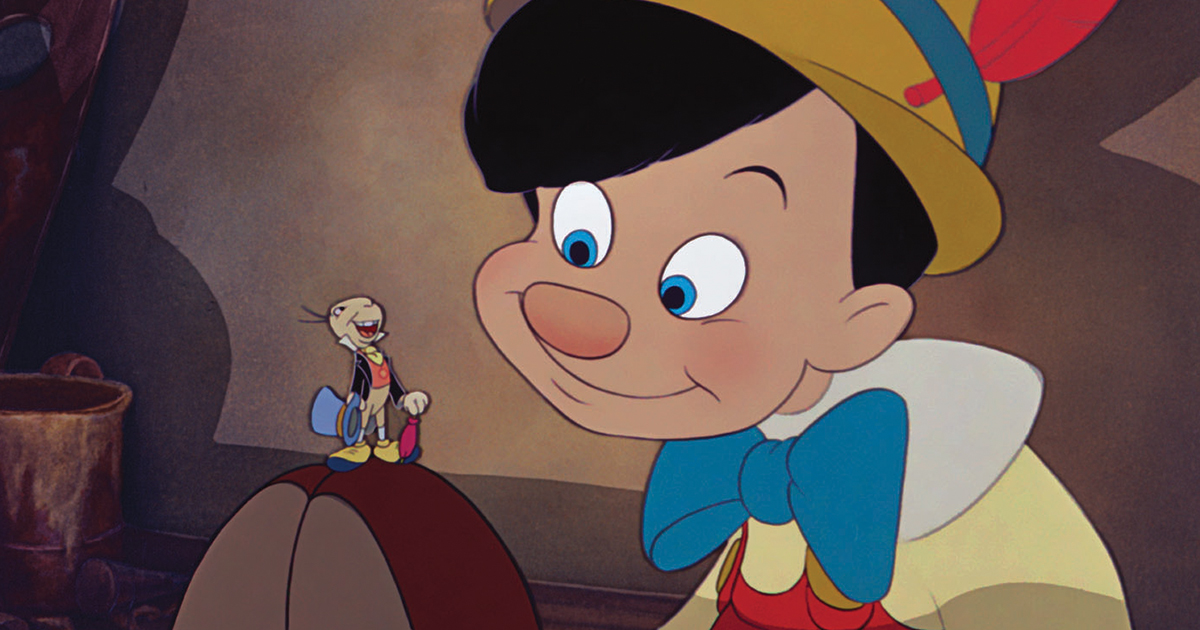[9]
Walt Disney followed up his success with Snow White and the Seven Dwarfs with a film that is far more entertaining and timeless. Pinocchio begins in a small cottage where a woodcarver named Geppetto (Christian Rub) is putting the finishing touches on a marionette puppet. As he and his pets — a cat named Figaro and a goldfish named Cleo — prepare for bedtime, Geppetto wishes that his new puppet were a real boy. His prayer is heard by the Blue Fairy (Evelyn Venable), who descends from the stars and brings the puppet, Pinocchio, to life — promising him that if he proves himself worthy, one day he will become a real boy. She appoints a wandering cricket named Jiminy (Cliff Edwards) as Pinocchio’s official conscience to help guide him through life’s moral temptations.
Pinocchio then becomes an episodic adventure. On his first day of school, Pinocchio (voiced by Dickie Jones) is distracted by a pair of opportunistic charlatans who sell him to a traveling puppeteer named Stromboli (Charles Judels). Stromboli imprisons Pinocchio with plans to exploit him to the fullest before chopping him up for firewood. Jiminy Cricket and the Blue Fairy come to the rescue, but Pinocchio soon finds himself caught up in another poor decision — a trip to Pleasure Island, where scores of boys are allowed to drink, smoke, and tear the place up. Jiminy once again comes to the rescue as the boys begin transforming into donkeys. Pinocchio grows donkey ears and a donkey tail before escaping with Jiminy. When they finally get back home to Geppetto, they learn the old woodcarver and his pets are long gone, searching high and low for their missing Pinocchio. The Blue Fairy informs them that Geppetto is at the bottom of the sea inside the belly of a fierce whale named Monstro. So Pinocchio sets off to find Monstro and save his family — and prove himself worthy of becoming a real boy.
The character animation and background paintings are all beautiful in Pinocchio. The film also introduces multi-plane photography, allowing the camera to move through different layers of foreground paintings for a more dimensional effect. But as with any great Disney animated classic, the quality of the animation is a given. It’s the story and characters that send Pinocchio over the top. Episodic narratives often lack cohesion, but Pinocchio works because each episode offers temptations that Pinocchio must resist in order to learn his own sense of morality. It’s a cautionary tale for young boys: listen to your conscience and do the right thing, or suffer the consequences.
Those consequences can be horrific, resulting in fractures to what Pinocchio is pursuing — his humanity. Skipping school and missing an education leads Pinocchio to be captured and exploited for manual labor. Indulging in vices at Pleasure Island literally turns boys into jackasses. Watching Pinocchio’s friend Lampwick (Frankie Darro) transform into a braying donkey while screaming for his mother is a scene that haunts my memory. It sobers up both Pinocchio and the audience. There’s a lot more that you can infer or decipher from Disney’s retelling of this classic story (I won’t get into Pinocchio’s phallic nose growing). But as with any great film, it can also be enjoyed strictly at face value. It’s a wonderful, charming film ripe with subtext and meaning if you choose to mine it. The film also features some of Disney’s most enduring songs, including “There Are No Strings On Me” and “When You Wish Upon a Star”.
Academy Awards: Best Score, Best Song (“When You Wish Upon a Star”)

